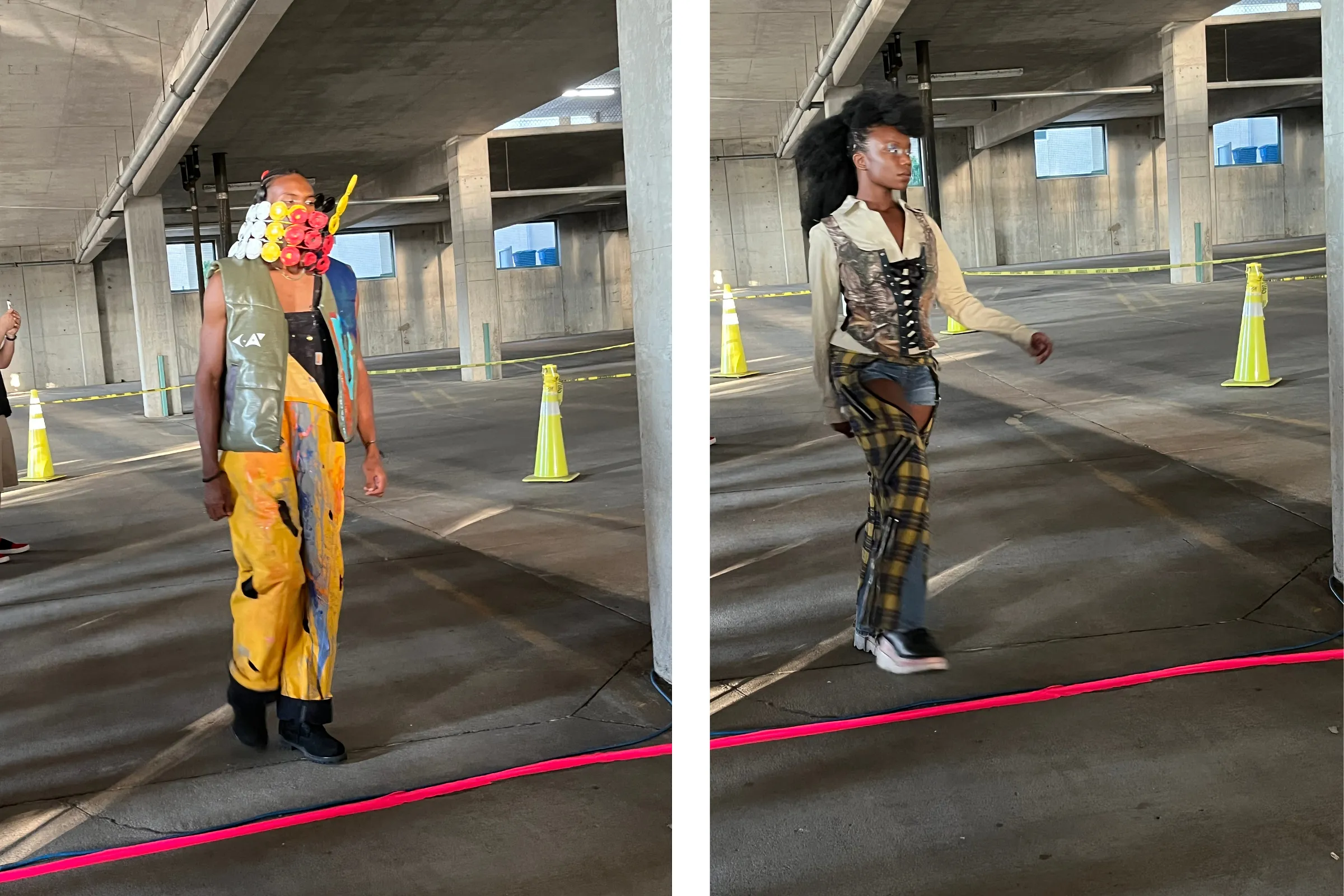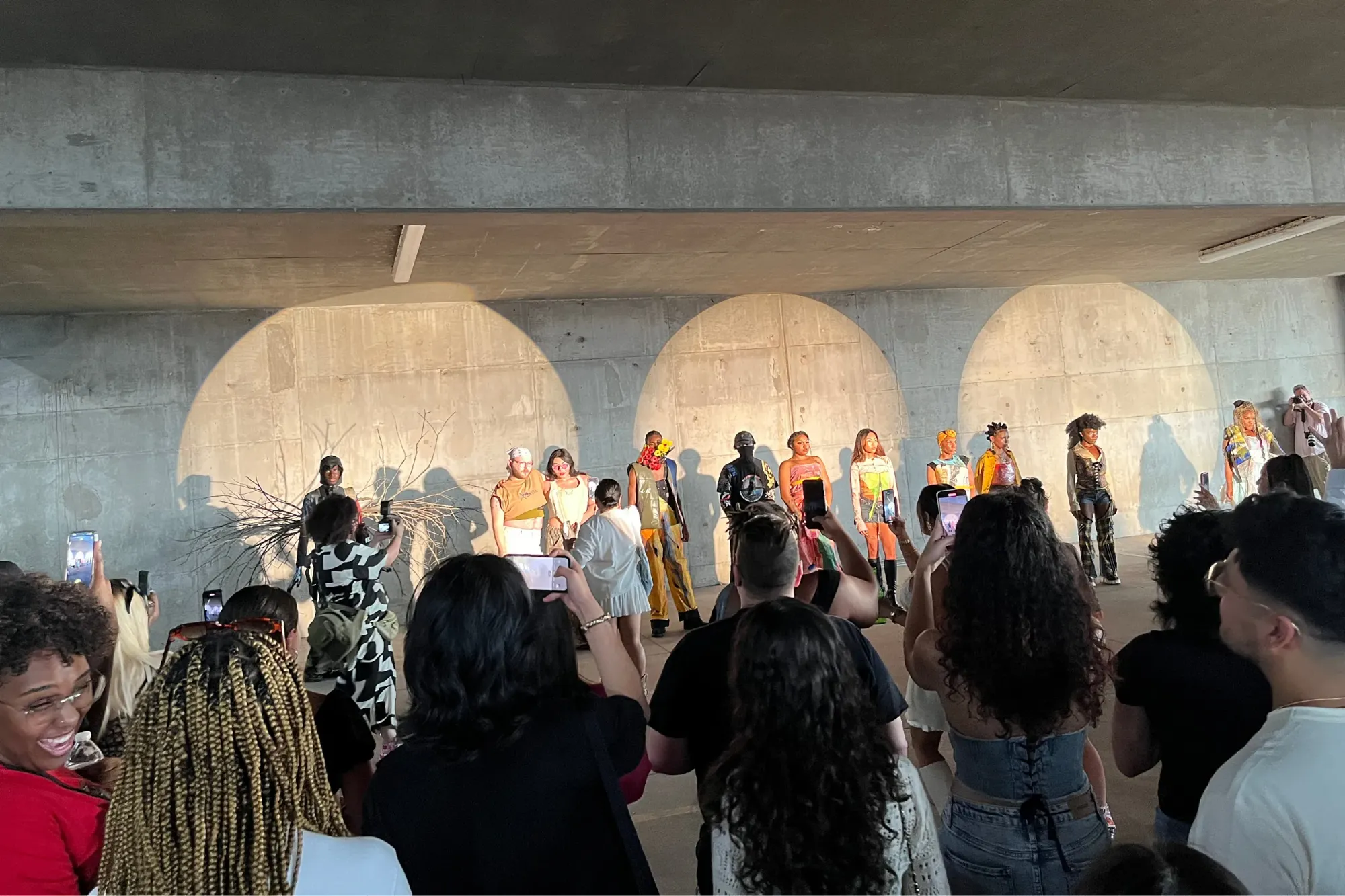Downtown Parking Garage Concert Series: “Super Imposed”
100 W. 1st St.
Tulsa
July 11, 2024
What’s the point of a downtown parking garage after all the workers go home for the day? What about a plastic bag after it’s done carrying your Granny Smith apples and energy drinks? Or a pile of tree limbs left behind after a storm or a visit from the PSO power line crew? What do we do, honestly, when systems that we were told would sustain us turn out to be crumbling, abandoned, unsustainable?
That got meta pretty fast, I know. But the longer I stood (dripping with sweat, gratefully slurping a strawberry mango ice pop from the Frios truck outside) in the concrete bunker of the 1st and Boulder parking garage during the underground runway event that popped up there last Thursday, the more questions like that — from the immediate to the sociopolitical — kept rising up and hanging together as casually-slash-intentionally as some of the garments on view.
Produced by Oklahoma Fashion Alliance’s Lolly Mclain, Atlas Fielding, and Parker D. Wayne in collaboration with Tulsa Creative Engine and the Downtown Tulsa Partnership, with support from Tulsa Remote and Tulsa FMAC, “Super Imposed” was the latest in a series of conceptually incisive, jubilantly unclassifiable events from OFA over the past year and change. The evening’s official lineup included three sets of music and a fashion show under the umbrella of a new initiative called the Downtown Parking Garage Concert Series. There was some after-party business that went on into the following morning, supported by OFA but not a TCE/DTP/TR/TFMAC thing. (Lots of acronyms, folks: a sign of an evolving creative ecosystem.)
A parking garage is a hell of an acoustic challenge for a musician, but it’s a prime spot for messing around with reverb, as the evening’s first performer, Peter Tomshany, noted on his socials after the show. I got there, thankful for free parking, during the excellent Sega-style “computer music” set by Kid Naps (Henry Roanhorse) that followed. The “concert” portion of the event (which DJ HiddenxDisplay wrapped up) felt like listening to busker music in a New York City subway station, with thwacks and blips bouncing off the walls as the space filled up with people in sequins and overalls who were chill about their multitasking: wave at friend, check chat, check fit, bop to beats, give hug, look for taco truck.
The crowd was heavily but not exclusively Gen Z and young Millennial, full of active artists and kids looking to break in. There’s a multilayered scene being born in Tulsa and it’s a beautiful one, massively diverse and affirming, and the response to this gathering reflected not just the social reach of OFA but the appeal of its approach to … just about everything. (Some of the older attendees looked like they didn’t quite know what to do with themselves, like Facebook sitting in a room with TikTok.)

Everyone’s attention focused quickly as Wayne introduced the runway moment and boom, down the slope came ten models to music by Peyton Flocks, walking into three huge spotlights projected onto the wall of the parking garage by lighting designer Logan Sours. The fashion show featured a collection called BOONIES — described by designers Swan Shekinaa and Icky Split as “cunTry cute from the stixxx” and “a limited brand on its way to the grave by design” — interspersed with pieces by the artist known as C.A.P.
This couldn’t be further from the fashion enterprises you might have in mind when you hear “runway,” but that doesn’t mean it’s not tight as hell. These were garments whose upcycling and remixing brought “adaptive reuse” into sharp focus in this empty downtown space: A massive gorget made from painted bottle caps. A flotation vest dripping with paint, trailing a net stuffed with plastic scraps. Plaid pants trimly cut into ass-baring chaps with tiny jorts underneath and a corset on top. A sky-blue dress made from what looked like mesh fencing, rakishly wrapped in a Macy’s bag. At the bottom of a strong look in yellow, pink, and black, shoes wrapped in plastic bags, like you wear if you don’t have snow boots in the winter.
And the most stunning moment of the show: two giant wings made out of bare branches, tied onto a backpack framed in sticks, worn by a model in a black peaked hood, black and white gloves, a grimy airbrushed tee, and a floor-skimming camo skirt. The wit of the “stixxx” reference came through for sure, but so did other resonances — angels, of course, or the man on the Ten of Wands tarot card (and the cover of Led Zeppelin IV, I guess) burdened by what he’s carrying, or someone who’s not sure where their next warmth or shelter’s coming from. It was a dark image, but light, too: not an angel of death, but someone picking up and keeping going, building what he’s gathered into something that could maybe let him fly.

The mood of all these pieces was not so much “post-apocalyptic” as “emergent futurism.” It was vibrant and confident, neither despairing nor escapist but clear-eyed, collected, and joyfully defiant. Don’t underestimate anything that looks like it’s doing “nothing” — an empty parking garage, for instance, or a plastic bag, or an artist, or Gen Z itself. Reclaiming what’s underappreciated, under-utilized, and underground (whether people, materials or public spaces), these artists are turning the detritus of 20th century capitalism into instruments for the voices of a generation that’s looking to live, not just survive. Siloing off what’s trash from what’s treasure is no longer the move, is one way to read it. It’s about what we do with it all, how we compost it, how we walk in what we make with what we have.
The proportions of this event might have felt off to someone used to more conventional “shows” — so much unseen prep time and so much celebratory party time sandwiching about 15 minutes of actual runway action and a pretty hot, stuffy, echo‑y music-listening experience. But the point of things like this is as much social wellness and cohesion as it is art-presentational. It’s to celebrate “what we’re doing together” rather than putting one thing or person on a pedestal to be admired.
And, importantly, it’s another slash in the veil between city infrastructure and social movement. It’s very satisfying to see young artists taking over spaces like this, as of course they’ve always done in Tulsa and elsewhere, usually semi-illegally or at considerable safety risk. Organizations like the Downtown Tulsa Partnership seem to have gotten the memo that supporting artist-driven “nontraditional” events like this is a smart move. Does it have a quantifiable outcome metric? No idea. Does it make our downtown feel more alive — like, a place that all kinds of people might be able to see themselves hanging out outside of corporate working hours? Absolutely. That’s a kind of vision I’m ready to see more of in the arts in Tulsa: one that values how creativity helps people thrive within the city that actually, at all hours, belongs to us.
Next Downtown Parking Garage Concert Series: July 25






